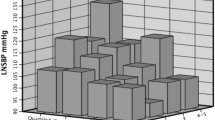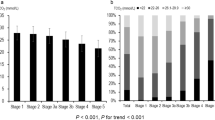Abstract
The current research on the relationship between 24-h central pressure and 24-h brachial pressure with left ventricular hypertrophy (LVH) is characterised by limited sample size and inconsistent findings. Furthermore, the association has never been explored in chronic kidney disease (CKD). A multicentre, cross-sectional study among non-dialysis patients with CKD was conducted. All participants underwent brachial and central ambulatory blood pressure monitoring using MobilO-Graph PWA, while trained cardiologists performed echocardiography. In this study, 2117 non-dialysis patients with CKD were examined. 24-h central systolic blood pressure with c2 calibration (24-h c2SBP) demonstrated a stronger association with left ventricular mass index and LVH compared with 24-h brachial systolic blood pressure (24-h bSBP) in the univariate and multivariate regression analyses. The multivariate net reclassification index (NRI) analysis revealed that 24-h c2SBP exhibited greater discriminatory power over 24-h bSBP (NRI = 0.310, 95% CI [0.192–0.429], P < 0.001). Applying 130/135 mmHg as the threshold for 24-h bSBP/c2SBP to cross-classify, the patients were divided into concordant normotension (1509 individuals), isolated brachial hypertension (155 individuals), isolated central hypertension (11 individuals), and concordant hypertension (442 individuals). With concordant normotension as the reference, the multivariable-adjusted ORs were 0.954 (95% CI, 0.534–1.640; P = 0.870) for isolated brachial hypertension and 2.585 (95%CI, 1.841–3.633; P < 0.001) for concordant hypertension. Among non-dialysis patients with CKD, 24-h c2SBP exhibits greater efficacy in identifying the presence of LVH compared with 24-h bSBP. The presence of LVH was greater in cases of concordant hypertension compared with cases of isolated brachial hypertension and concordant normotension.

This is a preview of subscription content, access via your institution
Access options
Subscribe to this journal
Receive 12 print issues and online access
$259.00 per year
only $21.58 per issue
Buy this article
- Purchase on Springer Link
- Instant access to full article PDF
Prices may be subject to local taxes which are calculated during checkout


Similar content being viewed by others
Data availability
The data underlying this article will be shared on reasonable request to the corresponding author.
References
GBD Chronic Kidney Disease Collaboration. Global, regional, and national burden of chronic kidney disease, 1990–2017: a systematic analysis for the Global Burden of Disease Study 2017. Lancet. 2020;395:709–33.
GBD 2019 Risk Factors Collaborators. Global burden of 87 risk factors in 204 countries and territories, 1990–2019: a systematic analysis for the Global Burden of Disease Study 2019. Lancet. 2020;396:1223–49.
Staplin N, de la Sierra A, Ruilope LM, Emberson JR, Vinyoles E, Gorostidi M, et al. Relationship between clinic and ambulatory blood pressure and mortality: an observational cohort study in 59 124 patients. Lancet. 2023;401:2041–50.
McEniery CM, Cockcroft JR, Roman MJ, Franklin SS, Wilkinson IB. Central blood pressure: current evidence and clinical importance. Eur Heart J. 2014;35:1719–25.
Williams B, Lacy PS, Thom SM, Cruickshank K, Stanton A, Collier D, et al. Differential impact of blood pressure-lowering drugs on central aortic pressure and clinical outcomes: principal results of the Conduit Artery Function Evaluation (CAFE) study. Circulation. 2006;113:1213–25.
Weber T, Protogerou AD, Agharazii M, Argyris A, Aoun Bahous S, Banegas JR, et al. Twenty-four-hour central (aortic) systolic blood pressure: reference values and dipping patterns in untreated individuals. Hypertension. 2022;79:251–60.
Mancia G, Kreutz R, Brunström M, Burnier M, Grassi G, Januszewicz A, et al. 2023 ESH Guidelines for the management of arterial hypertension The Task Force for the management of arterial hypertension of the European Society of Hypertension: Endorsed by the International Society of Hypertension (ISH) and the European Renal Association (ERA). J Hypertens. 2023;41:1874–2071.
Levy D, Garrison RJ, Savage DD, Kannel WB, Castelli WP. Prognostic implications of echocardiographically determined left ventricular mass in the Framingham Heart Study. N Engl J Med. 1990;322:1561–6.
Rodriguez CJ, Lin F, Sacco RL, Jin Z, Boden-Albala B, Homma S, et al. Prognostic implications of left ventricular mass among Hispanics: the Northern Manhattan Study. Hypertension. 2006;48:87–92.
Paoletti E, De Nicola L, Gabbai FB, Chiodini P, Ravera M, Pieracci L, et al. Associations of left ventricular hypertrophy and geometry with adverse outcomes in patients with CKD and hypertension. Clin J Am Soc Nephrol. 2016;11:271–9.
Mathew J, Sleight P, Lonn E, Johnstone D, Pogue J, Yi Q, et al. Reduction of cardiovascular risk by regression of electrocardiographic markers of left ventricular hypertrophy by the angiotensin-converting enzyme inhibitor ramipril. Circulation. 2001;104:1615–21.
Devereux RB, Wachtell K, Gerdts E, Boman K, Nieminen MS, Papademetriou V, et al. Prognostic significance of left ventricular mass change during treatment of hypertension. Jama. 2004;292:2350–6.
Verdecchia P, Schillaci G, Borgioni C, Ciucci A, Gattobigio R, Zampi I, et al. Prognostic significance of serial changes in left ventricular mass in essential hypertension. Circulation. 1998;97:48–54.
Weber T, Wassertheurer S, Schmidt-Trucksäss A, Rodilla E, Ablasser C, Jankowski P, et al. Relationship between 24-hour ambulatory central systolic blood pressure and left ventricular mass: a prospective multicenter study. Hypertension. 2017;70:1157–64.
Protogerou AD, Argyris AA, Papaioannou TG, Kollias GE, Konstantonis GD, Nasothimiou E, et al. Left-ventricular hypertrophy is associated better with 24-h aortic pressure than 24-h brachial pressure in hypertensive patients: the SAFAR study. J Hypertens. 2014;32:1805–14.
Omboni S, Posokhov I, Parati G, Arystan A, Tan I, Barkan V, et al. Variable association of 24-h peripheral and central hemodynamics and stiffness with hypertension-mediated organ damage: the VASOTENS Registry. J Hypertens. 2020;38:701–15.
Blanch P, Armario P, Oliveras A, Fernández-Llama P, Vázquez S, Pareja J, et al. Association of either left ventricular hypertrophy or diastolic dysfunction with 24-hour central and peripheral blood pressure. Am J Hypertens. 2018;31:1293–99.
Hu Y, Zhao J, Wang Q, Chao H, Tang B, Cheng D, et al. Disparate associations of 24-h central aortic and brachial cuff blood pressure with hypertension-mediated organ damage and cardiovascular risk. Front Cardiovasc Med. 2022;9:795509.
Argyris AA, Samara S, Blacher J, Papaioannou TG, Stergiou GS, Vlachopoulos C, et al. ‘Apples to oranges’ and ‘Less is more’. J Hypertens 2021;39:1262–64.
Matsushita K, Ballew SH, Wang AY, Kalyesubula R, Schaeffner E, Agarwal R. Epidemiology and risk of cardiovascular disease in populations with chronic kidney disease. Nat Rev Nephrol. 2022;18:696–707.
Rahman M, Wang X, Bundy JD, Charleston J, Cohen D, Cohen J, et al. Prognostic significance of ambulatory BP monitoring in CKD: a report from the chronic renal insufficiency cohort (CRIC) study. J Am Soc Nephrol. 2020;31:2609–21.
Protogerou AD, Aissopou EK, Argyris A, Nasothimiou EG, Konstantonis GD, Karamanou M, et al. Phenotypes of office systolic blood pressure according to both brachial and aortic measurements: frequencies and associations with carotid hypertrophy in 1861 adults. J Hypertens. 2016;34:1325–30.
Jones CR, Taylor K, Chowienczyk P, Poston L, Shennan AH. A validation of the Mobil O Graph (version 12) ambulatory blood pressure monitor. Blood Press Monit. 2000;5:233–8.
Franssen PM, Imholz BP. Evaluation of the Mobil-O-Graph new generation ABPM device using the ESH criteria. Blood Press Monit. 2010;15:229–31.
Gotzmann M, Hogeweg M, Seibert FS, Rohn BJ, Bergbauer M, Babel N, et al. Accuracy of fully automated oscillometric central aortic blood pressure measurement techniques. J Hypertens. 2020;38:235–42.
Weber T, Wassertheurer S, Rammer M, Maurer E, Hametner B, Mayer CC, et al. Validation of a brachial cuff-based method for estimating central systolic blood pressure. Hypertension. 2011;58:825–32.
Lang RM, Badano LP, Mor-Avi V, Afilalo J, Armstrong A, Ernande L, et al. Recommendations for cardiac chamber quantification by echocardiography in adults: an update from the American Society of Echocardiography and the European Association of Cardiovascular Imaging. J Am Soc Echocardiogr. 2015;28:1–39.e14
Devereux RB, Alonso DR, Lutas EM, Gottlieb GJ, Campo E, Sachs I, et al. Echocardiographic assessment of left ventricular hypertrophy: comparison to necropsy findings. Am J Cardiol. 1986;57:450–8.
Mancia G, Fagard R, Narkiewicz K, Redon J, Zanchetti A, Böhm M, et al. 2013 ESH/ESC guidelines for the management of arterial hypertension: the Task Force for the Management of Arterial Hypertension of the European Society of Hypertension (ESH) and of the European Society of Cardiology (ESC). Eur Heart J. 2013;34:2159–219.
Kawel-Boehm N, Kronmal R, Eng J, Folsom A, Burke G, Carr JJ, et al. Left ventricular mass at MRI and long-term risk of cardiovascular events: the multi-ethnic study of atherosclerosis (MESA). Radiology. 2019;293:107–14.
Bombelli M, Facchetti R, Carugo S, Madotto F, Arenare F, Quarti-Trevano F, et al. Left ventricular hypertrophy increases cardiovascular risk independently of in-office and out-of-office blood pressure values. J Hypertens. 2009;27:2458–64.
Imaizumi T, Fujii N, Hamano T, Yang W, Taguri M, Kansal M, et al. Excess risk of cardiovascular events in patients in the United States vs. Japan with chronic kidney disease is mediated mainly by left ventricular structure and function. Kidney Int. 2023;103:949–61.
Papaioannou TG, Karageorgopoulou TD, Sergentanis TN, Protogerou AD, Psaltopoulou T, Sharman JE, et al. Accuracy of commercial devices and methods for noninvasive estimation of aortic systolic blood pressure a systematic review and meta-analysis of invasive validation studies. J Hypertens. 2016;34:1237–48.
G Celler B, Butlin M, Argha A, Tan I, Yong A, Avolio A. Are korotkoff sounds reliable markers for accurate estimation of systolic and diastolic pressure using brachial cuff sphygmomanometry? IEEE Trans Biomed Eng. 2021;68:3593–601.
Smulyan H, Sheehe PR, Safar ME. A preliminary evaluation of the mean arterial pressure as measured by cuff oscillometry. Am J Hypertens. 2008;21:166–71.
Argyris AA, Mouziouras D, Samara S, Zhang Y, Georgakis MK, Blacher J, et al. Superiority of 24-hour aortic over 24-hour brachial pressure to associate with carotid arterial damage on the basis of pressure amplification variability: the SAFAR Study. Hypertension. 2022;79:648–58.
McGaughey TJ, Fletcher EA, Shah SA. Impact of antihypertensive agents on central systolic blood pressure and augmentation index: a meta-analysis. Am J Hypertens. 2016;29:448–57.
Meng L. Heterogeneous impact of hypotension on organ perfusion and outcomes: a narrative review. Br J Anaesth. 2021;127:845–61.
Pauca AL, O’Rourke MF, Kon ND. Prospective evaluation of a method for estimating ascending aortic pressure from the radial artery pressure waveform. Hypertension. 2001;38:932–7.
Nikorowitsch J, Bei der Kellen R, Haack A, Magnussen C, Prochaska J, Wild PS, et al. Correlation of systolic and diastolic blood pressure with echocardiographic phenotypes of cardiac structure and function from three German population-based studies. Sci Rep. 2023;13:14525.
Zhang L, Wang F, Wang L, Wang W, Liu B, Liu J, et al. Prevalence of chronic kidney disease in China: a cross-sectional survey. Lancet. 2012;379:815–22.
Jankowski J, Floege J, Fliser D, Böhm M, Marx N. Cardiovascular disease in chronic kidney disease: pathophysiological insights and therapeutic options. Circulation. 2021;143:1157–72.
Protogerou AD, Argyris A, Nasothimiou E, Vrachatis D, Papaioannou TG, Tzamouranis D, et al. Feasibility and reproducibility of noninvasive 24-h ambulatory aortic blood pressure monitoring with a brachial cuff-based oscillometric device. Am J Hypertens. 2012;25:876–82.
Luzardo L, Lujambio I, Sottolano M, da Rosa A, Thijs L, Noboa O, et al. 24-h ambulatory recording of aortic pulse wave velocity and central systolic augmentation: a feasibility study. Hypertens Res. 2012;35:980–7.
Wang Y, Zhang DY, Guo QH, Cheng YB, Huang QF, Sheng CS, et al. Short-term reproducibility of the 24-h ambulatory monitoring of brachial and central hemodynamics in untreated Chinese. Blood Press. 2019;28:250–57.
Acknowledgements
We sincerely appreciate all the patients for participating in this study.
Funding
This work was supported by the Five-five Project of the Fifth Affiliated Hospital of Sun Yat-Sen University.
Author information
Authors and Affiliations
Corresponding authors
Ethics declarations
Conflict of interest
The authors declare no competing interests.
Additional information
Publisher’s note Springer Nature remains neutral with regard to jurisdictional claims in published maps and institutional affiliations.
Supplementary information
Rights and permissions
Springer Nature or its licensor (e.g. a society or other partner) holds exclusive rights to this article under a publishing agreement with the author(s) or other rightsholder(s); author self-archiving of the accepted manuscript version of this article is solely governed by the terms of such publishing agreement and applicable law.
About this article
Cite this article
Chen, C., Liu, L., Liu, S. et al. 24-h central pressure is a valuable predictor for left ventricular hypertrophy in non-dialysis patients with chronic kidney disease. Hypertens Res (2024). https://doi.org/10.1038/s41440-024-01654-2
Received:
Revised:
Accepted:
Published:
DOI: https://doi.org/10.1038/s41440-024-01654-2



